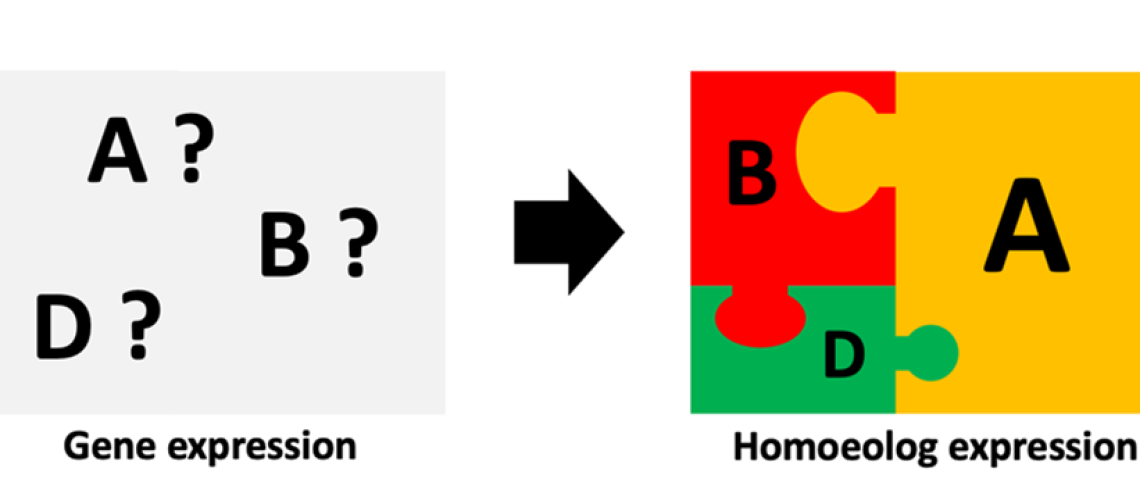

Marek Glombik
Postdoc MECEA Winner 2023
Solving the living puzzle: Homoeolog interaction in polyploid genomes
- Post-doc MECEA Winner 2023
- | Part of MECEA
Many economically important crops, such as wheat, cotton and coffee are allopolyploids, i.e., they originated from hybridisation of two or more species followed/preceded by whole genome duplication. The cells of these organisms therefore contain at least two different subgenomes which mutually coexist together. These subgenomes also express their corresponding “homoeologous” genes and understanding their interaction in the polyploid organism is highly important, as it enables proper utilization of these crops in breeding.
My first proper encounter with homoeologs happened in 2017, when I started my PhD research on gene expression in grass interspecific hybrids called Festulolium (Festuca pratensis x Lolium multiflorum) used mainly for turf and forage grass. The goal for the upcoming four years of my life was to describe the homoeolog expression in reciprocal Festulolium hybrids and to explain the parental effect on transcriptome changes in various conditions. This whole project captivated me with its complexity. As there was no published genome reference for either of the two species, I was put before a challenge. I had to come up with an unbiased method of analysis of gene expression for hybrid transcriptomic data. With advice and input from colleagues, I developed a k-mer approach which allowed us to analyse homoeolog expression without a need for genome reference. Using this approach, we revealed that significantly more genes in Festulolium hybrids mimicked overall gene expression of the Lolium parent compared with the Festuca parent, whereas the homoeolog expression bias displayed an opposite trend. This expression pattern was heritable to successive generation and its direction was only slightly modified by environmental conditions and plant age1.
I realised that understanding the homoeolog expression and its regulation is a key information to how parent-specific traits are exploited in hybrid crops. This could open a way for targeted breeding strategies as well as increase our understanding of allopolyploid genome evolution. And so, I decided to pursue this topic even further. In September 2022, I joined the Borrill lab at the JIC to study the inheritance of homoeolog expression bias in wheat. This project attracted me even more as wheat contains three subgenomes and the variation of homoeolog expression patterns (HEP) within these triads can have significant effect on plant phenotype2. Furthermore, these HEP may vary in different wheat varieties3. As making crosses between varieties is the cornerstone of the wheat breeding, it is crucial to know what happens when varieties with different HEP are crossed.
Therefore, we analysed RNA-seq data from 50 F6 lines, each coming from two biparental wheat crosses. To analyse the HEP in our samples, we measured coefficient of variation (CV) between expressed homoeologs within a triad. We discovered, that over 26 % of triads show significant unbalanced HEP between genotypes. Furthermore, we measured the relative distance between HEP of F6 lines and their parents in these triads. Whereas in one cross, a higher number of triads showed significantly more divergent HEP from only one parent rather than from both parents, triads in the other cross displayed an opposite trend. To understand, if these trends are associated with difference in DNA sequence between the parental wheat varieties, we performed variation calling and discovered over 80 000 SNPs. Using these SNPs, we now study the genetic influence on HEP.
Whether there is a direct link between HEP heritability and genotype remains undetermined for now, as the data is under ongoing investigation. However, we are slowly putting this puzzle together, unravelling more information with each discovered piece. To complete this puzzle, our next steps will test if heritability of HEP is accompanied by maintenance or changes in epigenetic marks, such as histone modification and DNA methylation. I believe that with all this information, we will be able to determine how the HEP is inherited, which will open some new exciting questions to ask and challenges for me to tackle.
References:
- Glombik, M., Copetti, D., Bartos, J., Stoces, S., Zwierzykowski, Z., Ruttink, T., … & Kopecky, D. (2021). Reciprocal allopolyploid grasses (Festuca× Lolium) display stable patterns of genome dominance. The Plant Journal, 107(4), 1166-1182.
- Shcherban, A. B., & Salina, E. A. (2017). Evolution of VRN-1 homoeologous loci in allopolyploids of Triticum and their diploid precursors. BMC plant biology, 17(1), 1-9.
- Ramírez-González, R. H., Borrill, P., Lang, D., Harrington, S. A., Brinton, J., Venturini, L., … & Uauy, C. (2018). The transcriptional landscape of polyploid wheat. Science, 361(6403), eaar6089.
